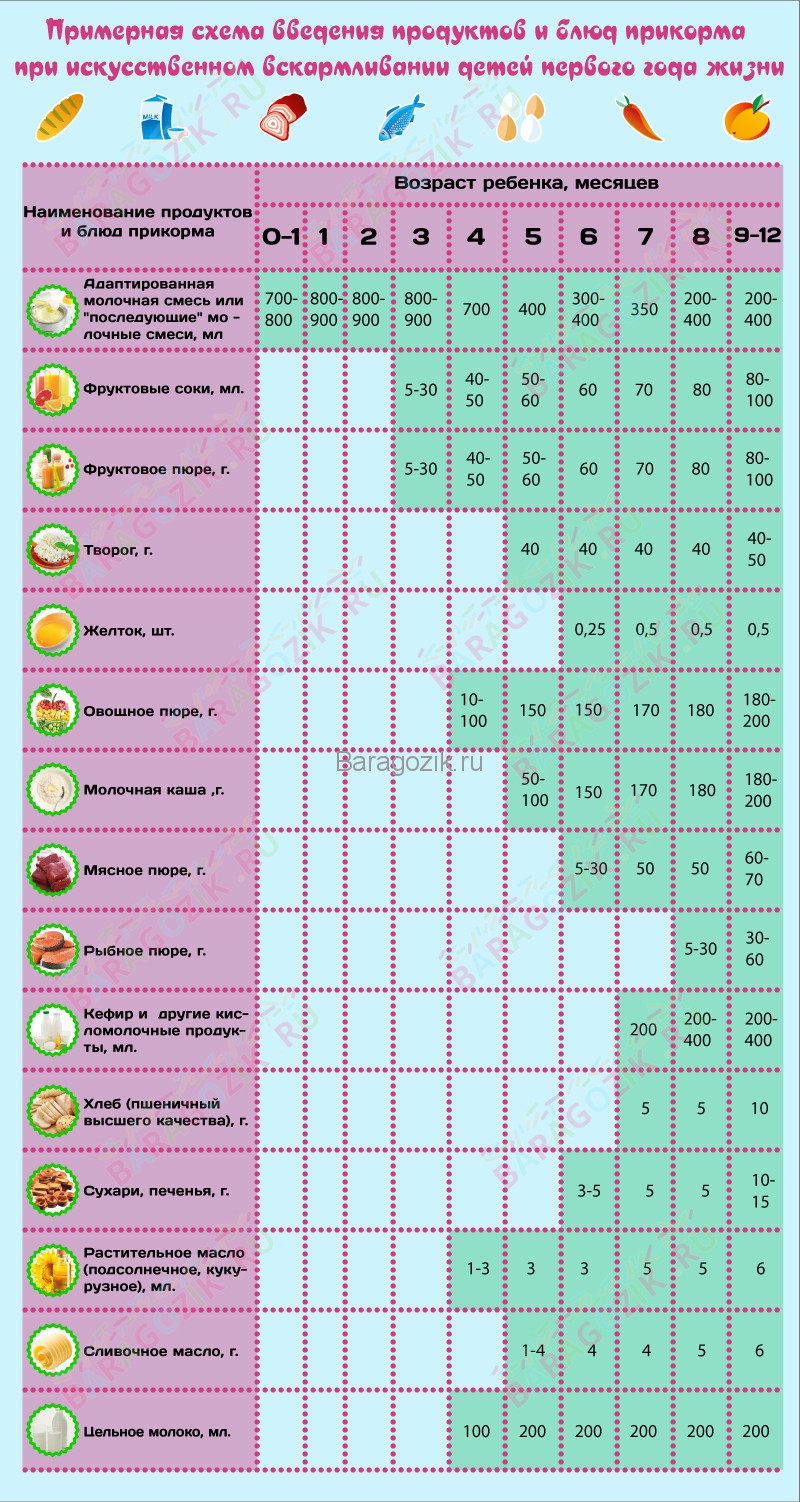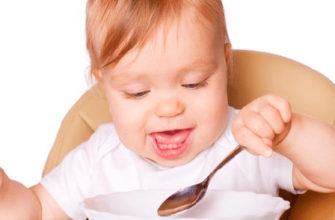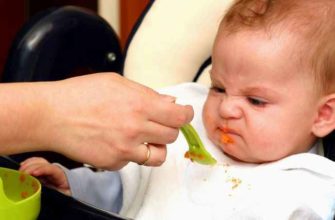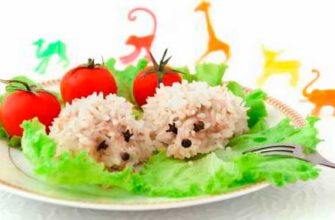Disputes between parents and grandmothers about when to introduce the first feeding to a child on artificial feeding begin as soon as the baby is a little older. The milk mixture is close to breast milk, but it is not able to completely replace it and provide the baby with all the necessary substances. The body of the artificer is used to getting the mixture and is easier to tolerate the introduction of other foods. Therefore, artificial foods are introduced a little earlier than for children receiving breast milk.

There is still disagreement among doctors regarding the timing of the first feeding. Some advocate the introduction of complementary foods from three months, motivating the baby's ventricle to be ready to take solid food. We will be guided by the norms of the World Health Organization, which recommend starting to introduce new food from 4.5 months.
We read in detail how to determine that a child is ready for feeding — 10 signs
We look at when to introduce complementary foods: exceptions to the rules:
The general scheme of the introduction of complementary foods during artificial feeding
(Click on the image to enlarge)

How to introduce complementary foods
We introduce complementary foods according to the scheme No. 1
- Proceed with the introduction of new food if the child is healthy (this is the iron rule);
- Give the crumbs one new product for him at a time;
- Start with juice, preferably apple juice (it does not cause allergies). First give a small portion (half a teaspoon). If the baby’s ventricle has taken good new food, gradually bring the single dose to the desired volume (see table. Here's the article about the first juice);
- Since the baby is used to getting the mixture first, give him a bottle, and then offer to try a new product;
- Give baby food only in the sitting position;
- Until the baby learns to chew, all solid foods must be macerated. You can dilute it with milk, a mixture or just boiled water to a liquid slurry. Make sure that for the first time lumps or small pieces do not come across in the puree, otherwise the crumbs may choke on them;
- After your baby gets used to the juice, try to give him fruit puree (again, it is better to start with apple);
- When the baby gets used to fruit puree, start accustoming him to vegetables.The least allergenic squash, pumpkin, cauliflower and broccoli. It is best to mash yourself by adding 2 to 3 drops of vegetable oil;
- Do not forget that the artificer needs give boiled water to drink;
- Prerequisite: start introducing a new product, making sure that the baby’s stomach is used to the previous one.
Give fruit
Where exactly to start feeding your baby - with vegetables or fruits, your pediatrician will tell you. Mashed potatoes are usually eaten with pleasure by children. It contains many vitamins and other substances necessary for a small child.
At the very beginning, to make mashed potatoes, it’s best to bake or steam the apple, pear, apricot, peach, and give the raw banana. Track the baby’s reaction to each new fruit. If everything is absorbed well, you can give fruit puree in the morning and in the evening.
We repeat, if you first introduce fruit sweet mashed potatoes, then it is likely that the child will eat mashed vegetables less well and it will be more difficult to introduce vegetable complementary foods! Here the choice is yours!
We introduce vegetables
Two weeks after the introduction of fruits, you can try to give mashed vegetables. Usually it is given for lunch feeding.
Watch your child’s health. If you have diarrhea or mucus in the feces, remove the vegetables from the child’s menu until the problems are completely eliminated. And only then try mashed vegetables again.
For the first time, make mashed potatoes from one type of vegetable, gradually accustoming the crumb ventricle to them. When the baby tries several types, you can cook mixed purees: from zucchini and pumpkin, from cauliflower and carrots, from broccoli and potatoes.
From vegetables, a baby up to a year can be given cabbage (cauliflower, broccoli, white cabbage), zucchini, pumpkin, potatoes, carrots, green peas, turnips, beets and, very carefully, tomatoes. Vegetable puree is allowed to slightly salted. And do not forget to drop a few drops of vegetable oil into it. Beets can stain your baby's feces and urine pink. It is not dangerous, do not worry.
Porridge with whole milk
To teach the baby to porridge start in a month - one and a half after vegetables. It is better to start with cereals that do not cause allergies: buckwheat, oatmeal. Then move on to the rest - corn, rice, semolina.
Recommendations for the first cereals (what cereals and how to correctly enter the child’s diet) >>>
You can cook porridge cowand goat milk. Goat is even preferable (About goat milk) At first, milk must be diluted in half with boiling water, then less and less and stopped diluting completely.
It is better to offer cereals for breakfast, vegetables for lunch.
We teach to meat
After six months, invite the baby to try mashed meat. You can buy ready-made in the store, or you can make it yourself by scrolling the meat in a meat grinder or rubbing it in a blender. It’s best to start with rabbit or turkey meat, then add chicken, beef and pork. A large amount of iron is present in mashed meat, which is especially important to prevent anemia. (See about mashed potatoes: how to introduce mashed meat in a child’s diet)
At 6 - 7 months, the child is given mashed meat, from eight you can already cook meatballs for a couple, and by the year - steam cutlets. Up to a year, it is undesirable to give the baby meat brothIt can provoke an allergy.
We also read:Meat in a child’s diet - the rules for introducing meat feeding
Egg yolk
More recently, the yolk began to give the baby at four months. Now doctors are proposing to introduce it into the baby’s nutrition from the age of seven months, starting with ¼ of the yolk. Before giving it to the baby, crush it and dilute it with milk or milk mixture to a liquid slurry. You can add the yolk to the vegetable or meat puree.
Cottage cheese
We add this product little by little and strictly in the specified rate. Too much cottage cheese will cause protein overload in the baby’s not very strong kidneys. Cottage cheese is needed to strengthen bones as an additional supplier of calcium. First, we dilute it with a mixture, later you can mix the cottage cheese with kefir. (Details about curd feeding)
We teach the baby to fish
Baby was 8 months old. From this time we gradually introduce fish, non-fat varieties (hake, cod, sea bass). Twice a week we give fish dishes instead of meat, for lunch or dinner. Vitamin D, so needed by him, comes into the baby’s body with fish. Moreover, it is absorbed better than meat.
Read on: feeding children on the GV
Some feeding tips
- Your baby is still very tiny. Therefore, it is better for him to take a small spoon - a coffee one.
- First let the baby suck on the mixture, and then offer new food. And only after accustoming him to her, give mashed potatoes at the beginning of feeding.
- Teach your child to eat at the same time. Frequency of feedings - 5-6 times a day.
- Do not force the baby to eat by force. Give him time to get hungry. And the crumb with pleasure will eat everything that was refused some time ago.
- It is more convenient to feed the child by putting him in a special chair.
- Get yourself a Diary of a child’s nutrition, where to write down what product you offered to the baby, when, how he perceived it. If the baby has an upset stomach or an allergic rash appears, the notebook will help both you and the doctor to quickly find the cause of the disease.
[sc: rsa]
What to do if you are allergic to a new type of complementary foods:
If you are in doubt about whether you are doing everything right, consult your doctor. The best indicator is the baby’s health. The child is cheerful, agile, growing and gaining weight in accordance with the standards, which means that you are on the right track.









My baby was on artificial feeding. The feeding began to be introduced from three months - a couple of drops of apple juice. I transferred well, there was no swelling or rash. The next step was a quarter of the yolk, it began to give at 4 months. And here the horror began. After the first time the child sprinkled in such a way that I was terrified. After that, they treated this diathesis for a long time and did not introduce new products for up to 6 months. Then everything was according to age, there were no more problems with complementary foods. I did not give eggs up to 2 years. Now eats and everything is fine. So, apparently, 4 months is too early for the yolk.
The first lure I introduced to my daughter at three months old with a little. We were on the mix already at that time. My milk disappeared very quickly. Began to give a spoonful of vegetable purees. Many told me that early and all that. But for that, our chair returned to normal .. So, I think it’s right not to listen to anyone. And listen only to yourself. After all, only you yourself know your baby and feel him ..
When my daughter was about 5-6 months old, we added fruit and vegetable puree to her diet. And then my baby rebelled - she didn’t like the vegetable puree. They tried for a long time to persuade her, and then one mom suggested what to do this: add a drop of vegetable puree to the familiar milk mixture to make it almost imperceptible.And then constantly increase the number of mashed potatoes, reducing the number of mixes. And this method really helped us.
I introduced complementary foods from carrot juice. But my baby is breastfeeding. Mashed potatoes began to eat vegetable from 7 months, then fruit, and then juices.
Weight gained normally.
For some reason I was very afraid of introducing complementary foods and very cautious, but quietly we started at 6 months old, our pediatrician advised why for some reason with cereals, from 8 months I started giving vegetables - potatoes, carrots, cauliflower, then summer just started and we started eating a lot of fruits, though some had to be abandoned (peaches), at 11 she started to give kefir, cottage cheese and only after a year we had almost all adult food gone without problems
Articles on this topic on your portal contradict themselves. In one place, you say that it is better to introduce complementary foods with vegetable purees, and leave the juices for later and then write about juices that they are at the beginning, in the table, the third infa in general and by number and by product and by time. Maybe you will still adhere to any one line of feeding, otherwise it turns out cheeseboarding and confusion in the head of mothers. It’s good to comment that there is a debate about what to give first, but you have different information from article to article
Thanks for the article, I will keep it in mind and keep it.
What kind of recommendations - not a word about kefir or yogurt, although the main discussion of baby food is based on the idea of giving juices or sour-milk drinks first. Moreover, when the rate of complementary foods increases, cereals and cereals are added, you just can not do without kefir to avoid dysbiosis and constipation in the child. Be sure to cook fresh kefir at home, you can take ready-made starter cultures for this, I advise Bakzdrav, I myself tried to give the baby from 8 months. And before that, they took the probiotic Bifidum sourdough for babies from six months later - not a single speck, no diathesis, or allergies after feeding.
Very strange article. WHO has never given a recommendation to introduce complementary foods before 6 months, where does such data come from? Regardless of the type of feeding, complementary foods are advised to be administered at 6 months and not earlier. An earlier introduction was practiced even at a time when the children of artificers were fed with diluted cow or goat milk, in this case there were really not enough nutrients and the earlier introduction of complementary foods was justified.